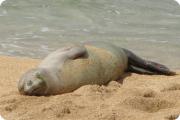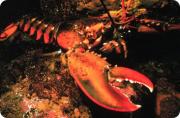Radio Program
Our regular Science and the SeaTM radio program presents marine science topics in an engaging two-minute story format. Our script writers gather ideas for the radio program from the University of Texas Marine Science Institute's researchers and from our very popular college class, Introduction to Oceanography, which we teach to hundreds of non-science majors at The University of Texas at Austin every year. Our radio programs are distributed at to commercial and public radio stations across the country.
It sounds like something “Q” would have whipped up in a James Bond movie: a submarine bristling with lights, cameras, and a robotic arm for finding and grabbing things on the ocean floor, and even wheels for “driving” along the bottom.
But Naval Research Vessel 1 -- NR-1 for short -- was a real submarine designed for real Cold War missions. And when it wasn’t pursuing super-secret military operations, it helped marine scientists probe the ocean depths.
Before the days of the Roman Empire, monk seals were just about as plentiful on Mediterranean beaches as tourists are today. Because of the seals’ love of sun and sea, the Greeks placed them under the protection of the gods Apollo and Poseidon.
Today, the Mediterranean monk seal could use a little of that divine protection. It’s one of the most endangered mammals in the world.
During one of his voyages to the New World, Christopher Columbus spotted a group of “sea wolves” lounging on the beaches of the present-day Dominican Republic. He ordered his men to kill eight of them for food. After that, it was all downhill for the Caribbean monk seal. The last one was seen in 1952, and a species that once ranged from the Florida Keys to the shores of South America has been declared extinct.
You can only push a person so far. In the early Massachusetts colony, for example, indentured servants were so incensed at the diet provided by their masters that they demanded a change: they couldn’t be required to eat lobster more than three times a week.
Such is the nature of changing times and changing tastes. In the 17th and 18th centuries, lobster was sneered at -- it was used for fertilizer or bait, or fed to slaves, criminals, and servants.
To fully understand how a living thing works, you have to study it under conditions like those in which it lives. And that applies down to the level of individual cells.
That’s one of the lessons learned and taught by Ernest Everett Just, one of the first African-American biologists.
Just was born in South Carolina in 1883. After his father died a few years later, his family moved to an island. There, Just developed a love of the nature around him -- a love that he maintained throughout his career.
An artificial reef sits on the floor of the Atlantic Ocean southeast of New York City -- a twisted Cold War artifact of steel and concrete. A few anglers and divers occasionally visit, but otherwise it sits quietly -- a memorial to the men who perished there, and to failed technology.
The structure was one of five “Texas Towers” -- named for their resemblance to offshore oil platforms -- that were planned to warn of Russian bomber attacks on the Northeast. Three were built, in the 1950s.
You don’t want to get a sperm whale riled up at you. An adult male can weigh up to 50 tons, and it’s one of the oceans’ hungriest predators, gulping down a ton of food per day.
In 1820, the whaling ship Essex was hunting sperm whales when a big male returned the favor. Perhaps thinking the ship was a rival, he rammed it twice, sinking the Essex and condemning her crew to months asea in lifeboats. The tale inspired Herman Melville to write “Moby Dick.”
Its brain is bigger than that of any other animal on Earth. It communicates through a series of loud clicks. And it forms long-lasting groups, with females apparently helping to raise each other’s young.
Yet the sperm whale is known less for its gentle and intelligent traits and more for a waxy substance in its head, occasional bouts of temper, and its aromatic poop.
Sperm whales are some of the largest animals on the planet. Adult males grow up to 60 feet long and weigh 40 or 50 tons.
By the time engineers capped the Deepwater Horizon oil spill in July of 2010, it had gushed almost five million barrels of oil into the Gulf of Mexico. Some of the effects were obvious, but others were less obvious.
Finding and studying them required a quick response. Within weeks of the spill, for example, a research team discovered a plume of oil beneath the surface that was 10 miles long and hundreds of feet thick. Later, another team found that a patch of coral a few miles from the well was dead or dying.
For the Pacific walrus, the summer hotspot is the fertile waters of the Chukchi Sea, which spans the gap between the northern coasts of Alaska and Siberia. It offers a mild climate and an almost endless buffet of clams.
Over the last few years, though, the accommodations have lost some of their appeal. The sea ice that serves as resting places and fishing platforms has thinned out -- sometimes disappearing completely.






